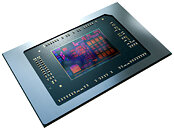- Joined
- Aug 19, 2017
- Messages
- 2,999 (1.07/day)
In recent developments, Linux's open-source graphics ecosystem is making significant strides to accommodate AMD's upcoming RDNA3.5 architecture, also known as RDNA3+ or GFX11.5. Mesa 23.3, a library in the Linux graphics software stack, is now being updated for RDNA3.5, marking a substantial milestone. This upcoming update is particularly tailored for the impending Ryzen 8000 "Strix Point" APU series, which will incorporate the Navi 3.5 architecture. While AMD has maintained secrecy regarding specific enhancements accompanying this refresh, we expect decent performance improvements. This includes the anticipation that the Ryzen 8000 APUs will feature an increased number of Compute Units (CUs), where the current highest number is 12 CUs, and the increase could bump that figure to 16 CUs. The official announcement of the Ryzen 8000 series is expected in early 2024 when we will learn more about its GPU configuration and performance.

View at TechPowerUp Main Site | Source

View at TechPowerUp Main Site | Source







